Flag of Mexico
 | |
| Use | National flag and ensign |
|---|---|
| Proportion | 4:7 |
| Adopted | 16 September 1968 |
| Design | A vertical tricolor of green, white and red, with the National Coat of Arms centered on the white band. |
| Designed by | Agustin de Iturbide (Original version) Francisco Eppens Helguera |
 | |
| Use | Naval jack |
| Proportion | 1:1 |
| Design | A diagonal tricolor of white, green, red, with a thin anchor in the center. Three eight-pointed gold stars are in the canton, and the bottom two corners. |
The national flag of Mexico (Spanish: bandera nacional de México) is a vertical tricolor of green, white, and red with the national coat of arms charged in the center of the white stripe. While the meaning of the colors has changed over time, these three colors were adopted by Mexico following independence from Spain during the country's War of Independence, and subsequent First Mexican Empire.
Red, white, and green are the colors of the national army in Mexico. The central emblem is the Mexican coat of arms, based on the Aztec symbol for Tenochtitlan (now Mexico City), the center of the Aztec Empire. It recalls the legend of a golden eagle sitting on a cactus while devouring a serpent that signaled to the Aztecs where to found their city, Tenochtitlan.[1]
History
[edit]
 The Twin Flags of Allende, a pair of flags that were made expressly by the then-captain of the Army of New Spain, Ignacio Allende, for the armed struggle that would begin on October 1, 1810, but since the date of the armed uprising was brought forward due to the discovery of the conspiracy, the flags had to be used without further preparation
The Twin Flags of Allende, a pair of flags that were made expressly by the then-captain of the Army of New Spain, Ignacio Allende, for the armed struggle that would begin on October 1, 1810, but since the date of the armed uprising was brought forward due to the discovery of the conspiracy, the flags had to be used without further preparation
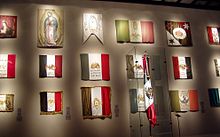
Before the adoption of the first national flag, various flags were used during the War of Independence from Spain. Though it was never adopted as an official flag, many historians consider the first Mexican flag to be the Standard of the Virgin of Guadalupe, which was carried by Miguel Hidalgo after the Grito de Dolores on September 16, 1810.[2] The Standard became the initial symbol of the rebel army during the Mexican War of Independence. Various other Standards were used during the war. José María Morelos used a flag with an image of the Virgin to which was added a blue and white insignia with a crowned eagle on a cactus over a three-arched bridge and the letters V.V.M. (Viva la Virgen María – "long live the Virgin Mary").[2] The Revolutionary Army also used a flag featuring the colors white, blue and red in vertical stripes. The first use of the modern colors—green, white and red—was in the flag of the unified Army of the Three Guarantees (pictured above) after independence from Spain was won.[3][dubious – discuss]
While similar to the national flag that is used today, the eagle in these arms is not holding a serpent in his talons and a crown has been affixed to the head of the eagle to signify the Empire. Variants of this flag that appeared in this period also included a naval flag that had the tricolor pattern, but it only contained the eagle with the crown above its head. The military also used a similar square flag, but the eagle was larger than the one on the national flag. The national flag was officially decreed by Agustín de Iturbide in November 1821 and first officially used in July 1822. [4]This flag was no longer used upon the abolishment of the empire.[5]
The first national flag was established in 1821, the first year of Mexican recognized sovereignty. The imperial government that was set up chose a tricolor flag of green, white, and red and charged with the national coat of arms. The official decree stated that
Sole article:... the national flag and flags of the army shall be tricolor, adopting forever the colors green, white and "encarnado" [flesh-colored red] arranged vertically, with the crowned eagle in the center of the white stripe, according to the following design[6]

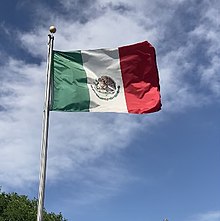

The second national flag was adopted after the establishment of the first federal republic in 1823. The new flag was chosen for the republic in April of that year, the only difference being the appearance of the central emblem. The crown was removed from the eagle's head and a serpent was placed in the eagle's right talon. Another addition to the flag is a branch of oak and laurel branches, a tradition that was carried over to the current flag. This flag was discontinued in 1864 upon the dissolution of the first federal republic.[7]
The third national flag was that of the Second Mexican Empire. Once again, the national flag used the green, white, and red tricolor pattern with the white stripe charged with the national arms. However, the ratio of the flag was changed from 4:7 to 1:2 and four eagles, which had crowns above their heads, were placed at each corner of the flag. The design, which was ordered by the Emperor Maximilian, gave the arms a look similar to the French Imperial arms, but he decided to add a bit of "Mexican flavor" to the flag. The coat of arms was described in a decree issued in November 1865 as:
oval in shape in blue; in the center is depicted the eagle of Anahuac, in profile and passant, supported by a cactus, supported, in turn, by a rock sunk on water, and ripping a snake. The border is gold charged by a garland of encino and laurel. The crest is the Imperial Crown. As supporters, two griffins from our elders' arms, their upper half in black and the lower in gold; behind the scepter and sword in saltire. The shield is surrounded by the collar of the Order of the Águila Mexicana, and the motto: "Equidad en la Justicia" [Equity in Justice][8]

 Reverse side of the flag
Reverse side of the flagThe current national flag was adopted on September 16, 1968, and was confirmed by law on February 24, 1984. The current version is an adaptation of the design approved by presidential decree in 1916 by Venustiano Carranza, where the eagle was changed from a front-facing to a side-facing position.[3] Before adopting the current national flag, the government used official flags. All of these flags used the tricolor pattern, with the only difference being the changes in the coat of arms, which was still charged in the center of the white stripe. One possible reason for the 1968 flag and arms change was that Mexico City was the host of the 1968 Summer Olympic Games.[9] Around this same period, the plain tricolor flag that Mexico used as its merchant ensign was also legally abandoned. The reasoning is that without the coat of arms, the flag would become nearly identical to the Italian flag.[10]
There was also debate in 1984 about how the coat of arms would be depicted on the reverse of the flag. To solve this problem, a PAN deputy proposed a change to the Law of the National Arms, Flag, and Anthem that same year to allow for the eagle to face to the right when the reverse of the flag is displayed.[11] In 1995, the law was changed to include the following:
When the National Arms is reproduced on the reverse side of the National Flag, the Mexican Eagle will appear standing on its right talon, holding with the left one and the beak the curved serpent.[12]
Design and symbolism
[edit]

The official design of the Mexican flag can be found in Article 3 of the Law on the National Arms, Flag, and Anthem, passed in 1984. While the exact shades of the flag have not been defined by law, in 2001 it was reported, through personal communication, to Flags of the World that the Interior Ministry (Secretaría de Gobernación) has suggested the following tones in the Pantone system;[13] nevertheless, the ministry has not officially ruled on the matter. So far, there are no official printed documents or statements on the color shades. The Pantone colors listed below were employed by the London Organising Committee of the Olympic Games and Paralympic Games Limited in its "Flag Manual".[14] while 2008 Beijing Olympic Games Flag Manual proposed others.[15]
| Colour scheme | Green | White | Red | |||
|---|---|---|---|---|---|---|
| Pantone[16] | 3425c | Safe | 186c | |||
| RGB[17] | 0-104-71 | 255-255-255 | 206-17-37 | |||
| CMYK[18] | 100-34-93-30 | 0-0-0-0 | 0-92-82-19 | |||
| Web colors[19] | 006847 | FFFFFF | CE1125 | |||
The article dictates what must be featured on the flag and also its proportions. Copies of the national flag which are made according to this law are kept in two locations: the General National Archive (Archivo General de la Nación) and the National Museum of History (Museo Nacional de Historia).
Art. 3: The Bandera Nacional is a rectangle divided into three vertical stripes of identical measures, with the colors placed in the following order from hoist to fly: green, white, and red. Centered in the white stripe, the National Coat of Arms has a diameter of three-fourths the width of the white stripe. The proportion of the flag is four to seven (Ratio 4:7). It could carry a rope or tie of the same colors below the truck.
Differences with Italian flag
[edit]
The Mexican tricolor (green, white, red) has been continuously used for a longer time than the Italian one. At the time of the Mexican flag's adoption, the similarly toned Italian tricolor had already been used briefly in Europe,[20] for example by the Cisalpine Republic in 1797, but it had different proportions from the modern Italian flag.[21]
Due to the common arrangement of the colors, at first sight, it seems that the only difference between the Italian and the Mexican flag is only the coat of arms of Mexico present in the latter. Both flags use the same colors (green, white, and red), but the Mexican flag has darker shades of green and red (particularly green). Additionally, these flags present a different aspect ratio (proportions): the Italian flag aspect ratio is 2:3 (1 to 1.5), more squarish in shape, while the Mexican flag aspect ratio is 4:7 (1 to 1.75), a longer shape.[22]
The similarity between the two flags posed a serious problem in maritime transport, given that originally the Mexican mercantile flag was devoid of arms and therefore was consequently identical to the Italian Republican tricolor of 1946; to obviate the inconvenience, at the request of the International Maritime Organization, both Italy and Mexico adopted naval flags with different crests.[23]
Protocol
[edit]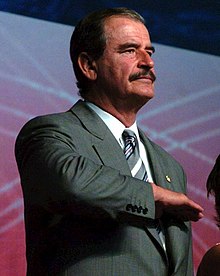
When the flag is paraded in front of a crowd, those in military uniform must present a salute according to military regulations. Civilians who are present give the following salute to the national flag: standing at attention (firms), they raise their right arms and place their right hands on their chests, in front of the heart. The hand is flat and the palm of the hand is facing the ground. This salute is known as the El saludo civil a la Bandera Nacional ("The Civil Salute to the National Flag"). When the President is acting in the capacity of the Head of the Armed Forces, he salutes the national flag with a military salute. When the national anthem is played on television to open or close daily programming, the national flag will be shown at the same time.[24] During certain times of the year, the flag is flown by both civilians and government personnel. Mostly, these events coincide with national holidays and days of significance to the country. During some of these occasions, the flag will be flown at half-mast to honor the death of important Mexicans. These dates are listed in Article 18 of the Law of the National Flag, Arms, and Anthem. The national Día de la Bandera (Flag Day) celebration occurs on February 24. On this day in 1821, all the factions fighting in the War of Independence joined to form the Army of the Three Guarantees in response to the Plan de Iguala, which was signed by Vicente Guerrero and Agustín de Iturbide, declaring Mexico officially an independent country. General Vicente Guerrero was the first military official who swore allegiance to the national flag.[3] Another flag tradition is that before every Olympics in which Mexico is a participant, the President hands a flag over to the flag bearer, chosen by their peers, to carry with them to the host city.[25]
Civil ceremonies
[edit]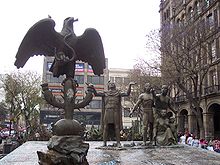
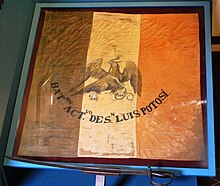
The flag songs are dedicated to the flag day, it is a national holiday in Mexico. Flag Day is celebrated every year on February 24 since its implementation in 1937.[26][27] The songs were established by President of Mexico General Lázaro Cárdenas before the monument to General Vicente Guerrero, first to pledge allegiance to the Mexican flag and Agustin de Iturbide:
|
|
|
|
Pledge of Fidelity
[edit]The following pledge of fidelity is taken every February 22 and any day whenever new flags are given to institutions in accordance with the form established by Article 3 of the Law on the National Arms, Flag, and Anthem:[28]
|
|
The pledge taking is taken on this day in a presentation of colours ceremony to units of the Armed Forces, National Guard, law enforcement and emergency organizations, as well as public schools and colleges of the Secretariat of Education.
Variants
[edit] | |
| Presidential Standard of Mexico | |
| Use | State flag |
|---|---|
| Proportion | 4:7 |
| Variant of the Presidential Standard | |
 | |
| Use | State flag |
| Cravat | |
 | |
There are two variants of the national flag that are mostly used by the state and federal governments, the difference between the national flag and the variants are the designs of the coat of arms. In the first variant, which is used by the President of Mexico and secretaries of federal bodies, the entire coat of arms is coloured gold, with the exception of the tricolour ribbon, which is green, white and red, and with the stone, lake and talons of the eagle coloured in silver. In the second variant, the entire coat of arms is coloured gold, even the ribbon, lake, stone and talons. The second variant is used mostly by the state governments and federal bodies who are not able to use the first variant.[29]
Law articles
[edit]- In Article 3 of the Law on the National Arms, Flag and Anthem (Ley sobre el Escudo, la Bandera y el Himno Nacionales) also describes that the national flag can be decorated with a special tie called a corbata (cravat). The corbata is composed of a bow, two ribbons of different length and both ribbons are attached with a golden tassel called fringe. The corbata is placed on the top of the flag at the point where the truck is, and the colours of the corbata match that of the national flag. Organizations and political parties can adopt their own corbatas, such as the National Action Party (PAN), which uses a white corbata with blue fringes.[30]
- In Article 3 of the Flag Law does not give an official symbolism to the colors, other meanings may be given to them. Other groups have used the national colors as part of their own logos or symbols. For example, the Institutional Revolutionary Party (PRI) political party has adopted the national colors as part of their logo. Another political party, the Party of the Democratic Revolution (PRD), also had the national colors as part of their logo, but changed them in the 1990s after a controversy surrounding impartiality issues, while the PRI did not.[31] Several states, such as Querétaro and Hidalgo have incorporated either elements of the national flag, or even the entire flag, into their coat of arms.

Regulations for use
[edit]The image of the flag is protected under law. A special permit is needed to broadcast its image. In February 2010, MTV Mexico controversially canceled a much-publicized broadcast of an episode of South Park, called "Pinewood Derby", featuring the flag, because it claimed that the permit had not been issued.[32]
In 2008, Mexican pop singer Paulina Rubio was fined for posing nude wrapped in the flag in a photo shoot for a Spanish magazine. [33]
Others
[edit]Other flags were flown as Mexican flags, either designed to intimidate the enemy or to act as identification. These flags were considered without subsequent formal documentation as national flag and temporally situated; Flag of Francisco I. Madero (February 9, 1913), Flag of Doliente Hidalgo (January 2, 1812), Flag of José María Morelos y Pavón, Flag of Francisco Villa, Flag of Siera Battalion, Flag of Jalisco Battalion, Libres de Puebla Battalion, Artillería Mina Battalion, Oaxaca Battalion, Toluca Battalion, Flag of Chihuahua Battalion, Flag of Durango Battalion, Flag of San Lorenzo Battalion, Flag of Lanceros Battalion, Flag of San Luis Potosí Battalion, Flag of Aguascalientes Battalion, Flag of Galeana Battalion (May 22, 1864), Flag of San Blas Battalion (September 24, 1846), Flag of Tres Villas Battalion, Flag of Milicias Battalion, Flag of Remixto Battalion, Flag of Quautla Battalion, Flag of 201 Squadron, Etc.[34]
Monumental flags
[edit]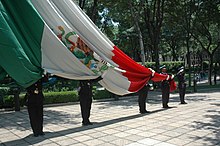
In 1999, President of Mexico Ernesto Zedillo started a program erecting giant flags across the country. Directed by the Secretariat of National Defense, the banderas monumentales (monumental flags) were placed in various cities and spots, most of which are of great significance to the nation. In a decree issued on July 1, 1999, by Zedillo, the flags were to be placed in Mexico City, Tijuana, Ciudad Juárez, and Veracruz. The decree also stipulated for the flags to measure 14.3 by 25 meters (47 by 82 ft), which are raised on flag poles that are 50 meters (160 ft) high. After these initial monumental flags were created, cities such as Ensenada, Nuevo Laredo and Cancún were reported to have their own monumental flags. Smaller flags, called banderas semi-monumentales, have been erected in smaller towns and at various educational institutes.[35]
As of December 22, 2010, the biggest Mexican flag in the world is now located in Piedras Negras, Coahuila.[36] Located at the Gran Plaza (Great Plaza) right across from International Bridge I connecting Piedras Negras with Eagle Pass, Texas. The pole is 120 meters (390 ft) in height and weighs 160 tonnes (180 short tons) making it the tallest one in Latin America and one of the tallest in the world. The flag measures 60 by 34 meters (197 by 112 ft) and weighs 420 kilograms (930 lb).[37]
Mexico's first largest monumental flag was the one located at the Mirador del Obispado in Monterrey (northeast) with a pole of 120 tonnes (130 short tons) and 100.6 meters (330 ft) in height. The flag measures 50 by 28.6 meters (164 by 94 ft) and weighs 230 kilograms (510 lb), four times the size of most other monumental flags at the time. It is located at the top of the Cerro del Obispado (Bishopric Hill) at an altitude of 775 meters (2,543 ft) above the sea level (city's altitude 538 meters or 1,765 feet).[38]
See also
[edit]- List of Mexican flags
- State flags of Mexico
- Flag flying days in Mexico
- Himno Nacional Mexicano
- Coat of arms of Mexico
References
[edit]- ^ Miller, Mary Ellen (2019). The Art of Mesoamerica: From Olmec to Aztec. Thames & Hudson. p. 245. ISBN 978-0-500-20450-4.
- ^ a b Diagrams of historical Mexican flags (in Spanish)
- ^ a b c Juán López de Escalera Diccionario Biográfico y de Historia de México, Editorial del Magisterio, México, 1964.
- ^ "Details", The World Factbook, Central Intelligence Agency, retrieved June 24, 2024
- ^ "Mexican Empire (1821–1823)". Flags Of The World. January 17, 2009. Archived from the original on August 10, 2004. Retrieved March 19, 2010.
- ^ January 7, 1822 Decree Establishing the Imperial Flag
- ^ "Mexico (1823-1864/1823-1880)". Flags Of The World. January 17, 2009. Archived from the original on October 16, 2005. Retrieved March 19, 2010.
- ^ November 1, 1865 Decree on the Imperial Arms
- ^ Page 45 of Adventure Guides Mexico's Pacific Coast by Vivien Lougheed, Hunter Publishing, ISBN 978-1-58843-395-4
- ^ Flags of the World page "Mexico – Flag without arms" Archived March 10, 2007, at the Wayback Machine (Archive page)
- ^ Flags of the World page "El reverso de la bandera de México y su simbolismo en la lucha por la independencia" [dead link]
- ^ Diario Oficial de la Federación (DOF) of May 9, 1995
- ^ Gabino Villascán, Juan Manuel. "Mexico". Flags of the World. Archived from the original on January 18, 2020. Retrieved January 18, 2013.
- ^ Flags, and Anthems Manual London 2012. London Organising Committee of the Olympic Games and Paralympic Games Limited. 2012. p. 91.
- ^ Gabino Villascán, Juan Manuel. "Mexico". Flags of the World. Archived from the original on February 9, 2009. Retrieved January 18, 2013.
- ^ Flags of the World page "Mexico" Archived March 8, 2008, at the Wayback Machine
- ^ Vexilla mundi page "Mexico" Archived February 11, 2005, at the Wayback Machine
- ^ Inkscape RGB to CMYK converter (approx.)
- ^ Adobe Photoshop RGB Translator
- ^ Ghisi, Enrico Il Tricolore Italiano (1796–1870) Milan: Anonima per l'Arte Della Stampa, 1931; see Gay, H. Nelson in The American Historical Review Vol. 37 No. 4 (pp. 750–751), July 1932 JSTOR 1843352
- ^ "Italy – Flags of the World". Archived from the original on January 27, 2023. Retrieved July 22, 2022.
- ^ "Mexican and Italian flag: differences and similarities". January 28, 2022. Archived from the original on January 27, 2023. Retrieved July 22, 2022.
- ^ "La bandiera Italiana" (in Italian). Archived from the original on March 3, 2016. Retrieved February 17, 2016.
- ^ "Artículo 41 Ley Sobre el Escudo, La Bandera y el Himno Nacionales (Article 41 of the Law of the National Arms, Flag and Anthem)". Info4.juridicas.unam.mx. Archived from the original on July 12, 2012. Retrieved March 20, 2012.
- ^ 2000 ceremony in Mexico to hand the national flag over from President Zedillo to flag-bearer Fernando Platas for the Sydney Olympics[usurped], canoe.ca, August 22, 2000
- ^ "February 24th: Mexico celebrates "Día de la Bandera"". February 23, 2022. Archived from the original on July 22, 2022. Retrieved July 22, 2022.
- ^ "24 de febrero, Día de la Bandera" (in Spanish). Archived from the original on February 24, 2022. Retrieved July 22, 2022.
- ^ "Ley sobre el escudo, la bandera y el himno nacionales" (PDF). Archived from the original (PDF) on December 20, 2018. Retrieved December 13, 2018.
- ^ Flags of the World page "Mexico – Coat of arms" Archived November 25, 2005, at the Wayback Machine
- ^ "Ley sobre el Escudo, la Bandera y el Himno Nacionales" (PDF) (in Spanish). Archived (PDF) from the original on June 30, 2022. Retrieved July 22, 2022.
- ^ Christian Science Monitor article on the PRI logo controversy[dead link]
- ^ Miglierini, Julian (February 10, 2010). "MTV under fire as it pulls South Park episode in Mexico". BBC News. BBC. Archived from the original on November 13, 2019. Retrieved February 10, 2010.
- ^ "Multa SEGOB a Paulina Rubio for posar con bandera Mexicana". El Universal. February 14, 2008. Archived from the original on November 15, 2017. Retrieved November 14, 2017.
- ^ SEDENA, Libro de banderas históricas
- ^ Installment of semi-monumental flags in León, Guanajuato September 9, 2005 (in Spanish)
- ^ "En Piedras Negras ondea la bandera de México más grande del mundo". Milenio.com. Archived from the original on September 5, 2012. Retrieved March 20, 2012.
- ^ Aguilar, Hilda (December 23, 2010). "En Piedras Negras, Izan Bandera más grande del mundo [ESPECIAL] – 23/12/2010 | Periódico Zócalo". Zocalo.com.mx. Archived from the original on March 24, 2019. Retrieved July 14, 2022.
- ^ Secretariat of Interior article Archived March 2, 2008, at the Wayback Machine (in Spanish)
External links
[edit]- The Flag of Mexico Archived October 10, 2014, at the Wayback Machine
- Mexico at Flags of the World
- Presidency of Mexico – National Symbols (in Spanish)
- Artes e historia – Bandera de Mexico (in Spanish)
- Las Banderas de México A Través de Su Historia (Especial: Día de la Bandera) (in Spanish)
